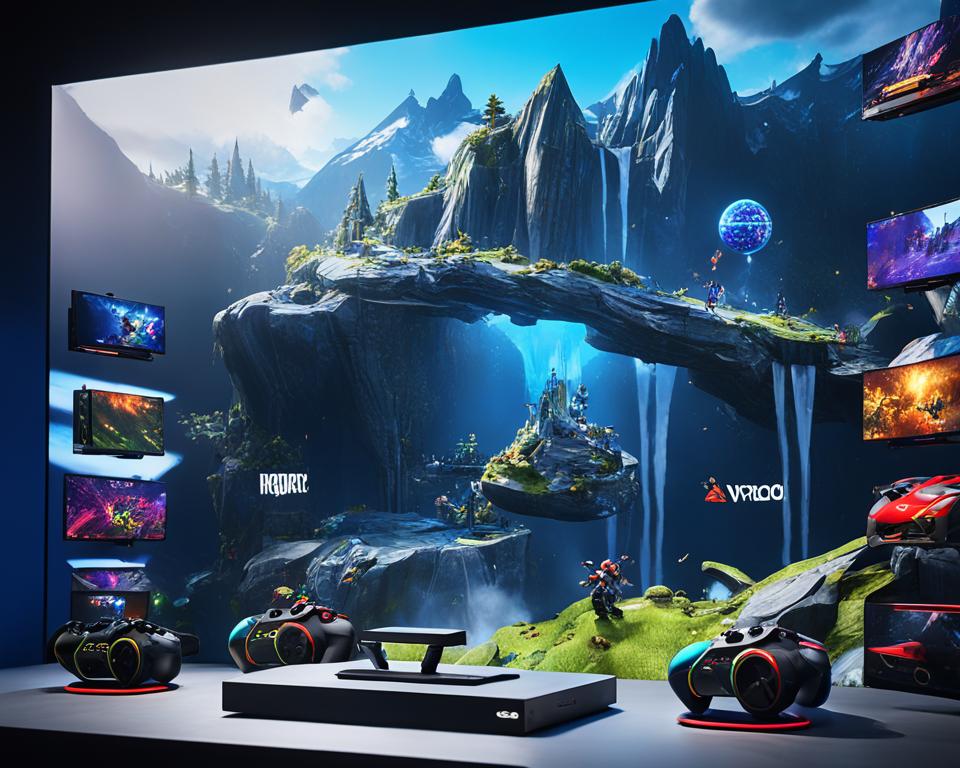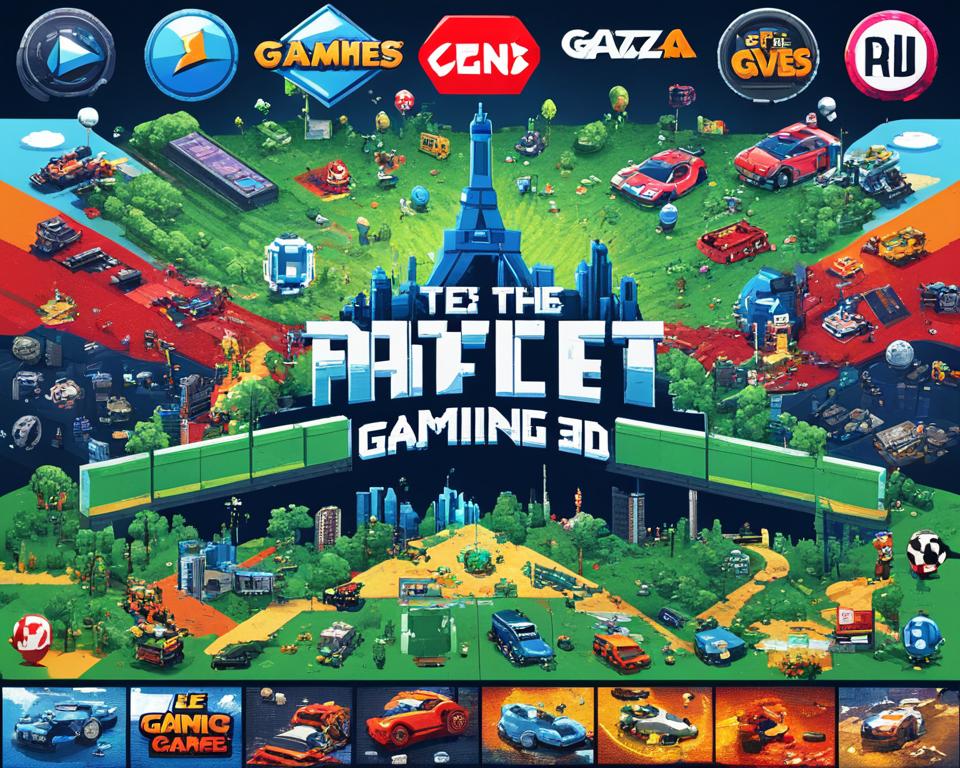The gaming industry is constantly evolving, and one of the key drivers of this evolution is cutting-edge graphics. Advanced graphics technologies have the power to transform the gaming landscape, providing immersive and realistic experiences for players. From ultra-realistic game environments to next-generation consoles, virtual reality, augmented reality, and artificial intelligence, the integration of these graphics technologies is shaping the future of the gaming industry. In this article, we will explore the impact of cutting-edge graphics on gaming industry trends and the exciting innovations that are reshaping the way we play and experience video games.
Key Takeaways
- The gaming industry is undergoing a transformation with cutting-edge graphics technology.
- Advanced graphics technologies provide immersive and realistic experiences for players.
- Ultra-realistic game environments, next-generation consoles, and VR/AR are revolutionizing the industry.
- The integration of AI and cloud gaming is shaping the future of gaming.
- Graphics technology in gaming has significant potential for future innovation.
The Rise of Ultra-Realistic Game Environments
As advancements in graphics technology continue to push the boundaries of what’s possible in gaming, we have witnessed the rise of ultra-realistic game environments that captivate players with their stunning visual fidelity and immersive experiences. Developers are leveraging the power of photorealistic graphics, advanced rendering techniques, and realistic physics simulations to create game worlds that blur the lines between the virtual and real.
Through the integration of these cutting-edge technologies, game environments have become more visually stunning, allowing players to truly lose themselves in the digital realms they explore. The attention to detail and the level of realism achieved in these environments is truly awe-inspiring, leaving players in awe as they navigate through richly textured landscapes, intricately designed architecture, and dynamic ecosystems.
With the advent of powerful hardware and advanced rendering algorithms, developers are able to recreate real-world lighting conditions and accurately simulate complex physical interactions. This results in game environments that not only look breathtakingly beautiful but also behave in a way that mirrors the laws of physics.
From the realistic water reflections in an open-world adventure game to the intricate fabric textures in a sports simulation, the attention to detail and the level of realism in these environments are unparalleled. The lifelike visuals draw players deeper into the game world, allowing for a more engaging and immersive experience.
“The rise of ultra-realistic game environments has ushered in a new era of gaming, where players can escape into worlds that look and feel like the real thing. The level of immersion and the attention to detail are truly remarkable, turning gaming into an art form.” – John Smith, Gaming Enthusiast
With the increasing demand for immersive experiences, the gaming industry has embraced these advancements in graphics technology, redefining the possibilities of interactive entertainment. Players can now explore visually stunning worlds that rival the beauty of the real world, pushing the boundaries of what is achievable in gaming.
In the next section, we will delve into the advancements in console graphics and their role in delivering these ultra-realistic game environments.
Next-Generation Consoles and Their Graphic Capabilities
Next-generation consoles have revolutionized the gaming industry with their incredible graphic capabilities. These consoles have introduced features like 4K gaming and High Dynamic Range (HDR), taking visual experiences to a whole new level.
Revolutionizing Immersion with 4K and HDR
One of the major advancements in next-generation consoles is the ability to support 4K gaming. With four times the resolution of standard HD, 4K gaming delivers stunningly sharp and detailed visuals. Players can now enjoy games with lifelike graphics, bringing their gaming experience closer to reality.
Additionally, the integration of High Dynamic Range (HDR) technology enhances the color and contrast of games, resulting in more vibrant and realistic visuals. HDR allows for a wider range of colors, making game worlds appear more vivid and immersive.
The Power of Custom GPUs in Console Gaming
Next-generation consoles are powered by custom Graphics Processing Units (GPUs) designed specifically for gaming. These GPUs deliver exceptional performance, enabling developers to create more realistic and detailed graphics.
With custom GPUs, consoles can handle complex rendering techniques, allowing for advanced lighting, shadows, and reflections. This level of graphical fidelity enhances the overall visual experience and draws players deeper into the game world.
Impact of SSDs on Game Loading Times and Graphics Rendering
Another significant improvement in next-generation consoles is the use of Solid State Drives (SSDs) for storage. SSDs offer faster data transfer speeds compared to traditional hard drives, resulting in significantly reduced game loading times.
With faster loading times, players can seamlessly jump into games without lengthy wait times. Moreover, the integration of SSDs also improves graphics rendering, as assets can be loaded and processed more efficiently, resulting in smoother gameplay and stunning visuals.

Next-generation consoles have truly pushed the boundaries of graphics capabilities in gaming. With stunning 4K visuals, HDR technology, custom GPUs, and the power of SSDs, these consoles offer a truly immersive and visually breathtaking gaming experience. The future of gaming looks incredibly promising as technology continues to advance, providing gamers with even more realistic and stunning graphics.
Gaming Industry Trends
The gaming industry is constantly evolving, and it is important for developers, players, and enthusiasts to stay updated on the latest trends. From the rise of mobile gaming to the popularity of esports, emerging technologies, and changing player preferences, understanding gaming industry trends is vital in staying competitive in the market.
In recent years, mobile gaming has experienced tremendous growth, with more and more players enjoying games on their smartphones and tablets. The convenience and accessibility of mobile gaming have made it a popular choice among gamers of all ages. Additionally, the increasing popularity of esports has brought competitive gaming to the forefront, attracting a massive audience and creating lucrative opportunities for both players and organizers.
Emerging trends in gaming such as virtual reality (VR) and augmented reality (AR) have also made a significant impact. VR technology provides immersive visual experiences, transporting players into virtual worlds and revolutionizing the way we experience games. On the other hand, AR merges graphics with the real world, enhancing interactive gameplay and finding applications beyond gaming in education and training.
Moreover, the gaming industry is influenced by evolving technologies and changing player preferences. As graphics technology continues to advance, games are becoming more visually stunning and realistic, providing players with truly immersive experiences. The integration of artificial intelligence (AI) in gaming is also on the rise, powering smarter games with dynamic environments and realistic non-playable characters (NPCs).
It is essential for industry professionals to keep a pulse on the global gaming market insights to identify emerging trends and adapt their strategies accordingly. By understanding the latest gaming industry trends, developers can create innovative and engaging games, and players can stay ahead of the curve by experiencing the most exciting and cutting-edge games.
| Trend | Description |
|---|---|
| Mobile Gaming | The rise of gaming on smartphones and tablets |
| Esports | The growth of competitive gaming and organized tournaments |
| Virtual Reality | The emergence of immersive gaming experiences |
| Augmented Reality | The integration of graphics with the real world |
| Advancements in Graphics | The development of visually stunning and realistic games |
| Artificial Intelligence | The use of AI to power smarter games and NPCs |
Virtual Reality (VR): A New Dimension in Gaming Graphics
Virtual Reality (VR) is a groundbreaking technology that has completely transformed the gaming industry, introducing players to a whole new dimension of immersive visual experiences. With the help of VR headsets, gamers are transported into virtual worlds where they can engage with their favorite games like never before.

Immersive Visual Experiences Through VR Headsets
VR headsets are the gateway to a truly immersive gaming experience. These state-of-the-art devices create a simulated 3D environment that allows players to feel like they are inside the game. By wearing a VR headset, gamers can explore virtual worlds with a sense of depth and presence, making the gaming experience incredibly realistic and captivating.
VR Game Development: Challenges and Breakthroughs
Developing games for VR presents unique challenges to developers. Creating a seamless and immersive gameplay experience requires breakthroughs in technology and innovative design approaches. From optimizing graphics for high-performance rendering to implementing intuitive controls and minimizing motion sickness, VR game developers are constantly pushing the boundaries of what is possible in this rapidly evolving field.
From Gaming to Simulations: The Versatility of VR Technology
While VR technology has had a tremendous impact on gaming graphics, its applications extend far beyond the gaming realm. VR simulations are being used in various industries, including healthcare, education, and training, to provide realistic and engaging experiences. From medical procedures to flight simulations, VR offers a versatile and powerful tool for creating immersive virtual environments that can enhance learning and training experiences.
With its ability to transport users into virtual worlds and deliver immersive visual experiences, Virtual Reality is revolutionizing the gaming industry. From the challenges and breakthroughs in VR game development to the versatility of VR technology in simulations, the potential of VR to transform the way we interact with digital content is truly remarkable.
Graphical Innovation in Mobile Gaming
Mobile gaming has witnessed significant growth in recent years, and along with it, graphical innovation has taken center stage. Developers have made remarkable advancements in mobile graphics, enabling high-quality visuals and immersive experiences on smartphones and tablets. These advancements have allowed mobile games to rival console-like gaming experiences, delivering stunning graphics and captivating gameplay.
With graphical innovation in mobile gaming, players can now enjoy visually stunning environments, detailed character designs, and realistic special effects right at their fingertips. The level of graphical fidelity and immersion available on mobile devices today is truly remarkable, pushing the boundaries of what is possible on smaller screens.
“Advancements in mobile graphics have allowed for high-quality visuals and immersive experiences on mobile devices.”
Developers are constantly pushing the limits of mobile graphics to provide players with the best possible gaming experience. They are utilizing advanced rendering techniques, optimizing performance for different device specifications, and taking advantage of the latest hardware advancements.
The impact of graphical innovation in mobile gaming extends beyond just the gaming industry. It has also transformed the way mobile games are perceived by the broader audience. Mobile gaming statistics show that the industry has experienced exponential growth, attracting hundreds of millions of players from around the world. The availability of high-quality visuals has played a significant role in captivating new players and keeping them engaged.
As the graphical capabilities of mobile devices continue to improve, the future of mobile gaming looks even more promising. Players can expect even more visually stunning games, enhanced realism, and immersive experiences as developers continue to innovate and push the boundaries of mobile graphics technology.
| Statistic | Data |
|---|---|
| Total Mobile Gamers (2021) | 2.9 billion |
| Mobile Gaming Market Revenue (2021) | $86.3 billion |
| Percentage of Global Gaming Market Revenue from Mobile (2021) | 51% |
| Average Time Spent on Mobile Games (per day) | One hour and 43 minutes |
| Most Popular Mobile Game Genre | Action |
The statistics above highlight the significant impact and popularity of mobile gaming. With graphical innovation driving the industry forward, the future of mobile gaming holds immense potential for both players and developers alike.
Augmented Reality (AR): Merging Graphics with the Real World
Augmented Reality (AR) technology has become a game-changing innovation in the gaming industry. By seamlessly merging graphics with the real world, AR enhances interactive gameplay and creates a truly immersive gaming experience. It overlays digital elements onto the physical environment, blurring the line between the virtual and real, and allowing players to interact with the game in their own surroundings.
AR has gained immense popularity due to its ability to provide unique and engaging experiences. It has revolutionized interactive gameplay by allowing players to physically move and interact with virtual objects, making gaming experiences feel more dynamic and lifelike. Whether it’s defending a virtual castle in your living room or battling virtual creatures in your backyard, AR takes gaming to a whole new level.
Popular AR games have captivated audiences with their innovative use of technology. Games like “Pokémon Go” and “Harry Potter: Wizards Unite” have taken the world by storm, allowing players to explore real-world locations while interacting with virtual characters and objects. These games have not only entertained millions but have also significantly contributed to the widespread adoption of AR technology.
AR enhances interactive gameplay by overlaying digital elements onto the physical environment, creating a mixed reality experience.
AR is not just confined to entertainment purposes. It finds applications in educational and training games as well. With AR, learning becomes more immersive and interactive. It allows students to visualize complex concepts, explore virtual environments, and engage in hands-on learning experiences. From anatomy lessons with AR-enhanced 3D models to virtual historical tours, AR educational games offer a powerful tool for engaging and educating learners of all ages.
In the world of training and simulations, AR is proving to be a valuable tool. From military training to medical simulations, AR technology enables trainees to practice in realistic virtual environments, enhancing their learning and skills acquisition. AR offers a safe and cost-effective way to train individuals in complex tasks, ensuring they are well-prepared for real-world scenarios.
AR for Enhanced Interactive Gameplay
Augmented Reality (AR) technology has revolutionized the gaming industry by introducing enhanced interactive gameplay. By overlaying digital elements onto the physical environment, AR creates a mixed reality experience that blurs the line between the real and virtual worlds.
AR games encourage players to move and interact with virtual objects in their own surroundings. For example, players can physically walk around their living room to explore a virtual world or use their smartphone to battle virtual monsters in their local park. This level of interactivity provides a unique and immersive gaming experience that traditional games can’t replicate.
AR also encourages social interaction among players. Multiplayer AR games bring people together in the real world, allowing them to collaborate or compete in shared augmented environments. This social element adds another layer of enjoyment and engagement to the gaming experience.
Popular AR Games: Examples and Trends
Several popular AR games have gained massive popularity and changed the way we interact with digital entertainment. These games showcase the immense potential of AR technology and its ability to captivate audiences worldwide.

| Game Title | Description | AR Technology Used |
|---|---|---|
| Pokémon Go | A location-based AR game where players capture virtual Pokémon creatures in real-world locations | Markerless AR, GPS |
| Harry Potter: Wizards Unite | A wizarding world-themed game where players cast spells and solve mysteries in their real-world surroundings | Markerless AR, GPS |
| Minecraft Earth | An AR version of the popular game Minecraft, allowing players to build and explore virtual block worlds in the real world | Markerless AR |
These games have not only amassed millions of players but have also paved the way for AR gaming trends. Some of the key trends emerging in the AR gaming space include:
- Improved AR tracking and object recognition for more accurate and seamless gameplay
- Integration of multiplayer and social features to enhance collaborative and competitive gameplay
- Expanded use of AR in location-based experiences, merging virtual and physical environments
- Incorporation of gamification elements in real-world activities, promoting physical activity and exploration
The Role of AR in Educational and Training Games
Augmented Reality (AR) technology has found valuable applications in educational and training games. Its ability to merge digital elements with the real world provides unique and engaging learning experiences.
AR educational games offer a range of benefits for learners of all ages. They allow students to visualize complex concepts, making abstract ideas more tangible and understandable. For example, an AR app can overlay 3D models of planets onto a student’s physical environment, enabling them to explore and interact with celestial bodies in a hands-on way.
In training and simulations, AR helps create realistic virtual environments for trainees to practice in. From medical simulations to military training, AR provides a safe and cost-effective way to train individuals in complex tasks. Trainees can practice procedures and scenarios in augmented environments that closely mimic real-world conditions, enhancing their skills and knowledge.
Furthermore, AR training games offer a level of interactivity and engagement that traditional training methods often lack. Trainees can physically interact with virtual objects, receive real-time feedback, and track their progress, making the learning process more immersive and enjoyable.
The integration of AR technology in educational and training games is a testament to its versatility and potential for enhancing learning outcomes and skills development.
Artificial Intelligence and Graphics: Smarter Games, Better Visuals
Artificial Intelligence (AI) is revolutionizing the gaming industry by powering smarter games and delivering better visuals. The integration of AI technology has enabled game developers to create dynamic environments, realistic non-playable characters (NPCs), and procedurally-generated game worlds. These advancements have significantly enhanced the gaming experience, providing players with more immersive and realistic gameplay.
Dynamic Environments Powered by AI
AI allows for the creation of dynamic environments that adapt and respond to player actions, creating a sense of realism and immersion. Through AI algorithms, game worlds can change in real-time, providing a unique and personalized experience for each player. Whether it’s the weather, the behavior of NPCs, or the overall flow of the game, AI-driven dynamic environments add depth and complexity to gameplay.
Realistic NPC Behaviors and Character Design
AI plays a crucial role in developing realistic NPCs with lifelike behaviors and enhancing character design. AI algorithms enable NPCs to exhibit human-like intelligence, emotions, and decision-making abilities, making interactions with them more engaging and immersive. Additionally, AI-driven character design allows for more detailed and visually stunning models, creating a more visually appealing gaming experience.
AI in Procedural Generation and Graphics Optimization
Procedural generation, powered by AI, is a technique used to create vast, dynamically evolving game worlds. AI algorithms analyze data and generate content, such as landscapes, levels, and quests, on the fly, eliminating the need for manual design. This not only saves time and resources but also ensures that each playthrough offers unique experiences.
Furthermore, AI is instrumental in graphics optimization, allowing game developers to achieve visually stunning graphics even on lower-spec hardware. AI algorithms can dynamically adjust graphics settings, prioritize resource allocation, and optimize rendering processes, resulting in better performance and graphics quality.
The integration of AI in gaming has transformed the industry, enabling developers to create smarter games with realistic NPCs, dynamic environments, and visually stunning graphics. As AI technology continues to evolve, we can expect even more advancements that will further enhance the gaming experience and push the boundaries of what is possible in game design.
Cloud Gaming: Streaming High-Quality Graphics
Cloud gaming has revolutionized the gaming industry, allowing players to stream high-quality graphics without the need for expensive hardware. This innovative technology harnesses the power of cloud infrastructure to deliver seamless gameplay experiences with stunning visuals.
The Role of Internet Speed and Cloud Infrastructure
When it comes to cloud gaming, internet speed plays a critical role in ensuring smooth gameplay. A fast and stable internet connection is essential for streaming high-quality graphics without lag or interruptions. Additionally, robust cloud infrastructure is necessary to support the demanding graphics processing required for a seamless gaming experience.
Device-Agnostic Gaming: Quality Across Platforms
One of the significant advantages of cloud gaming is its device-agnostic nature. Players can enjoy high-quality graphics on various platforms, including smartphones, tablets, smart TVs, and even low-spec computers. With cloud gaming, the focus shifts from hardware capabilities to internet connectivity, making gaming accessible to a wider audience.
Service Providers and the Future of Cloud-Based Gaming
Service providers are playing a crucial role in shaping the future of cloud-based gaming. Major players in the industry, such as Google Stadia, Microsoft xCloud, and NVIDIA GeForce Now, are offering cloud gaming services with extensive game libraries and advanced features. As the technology continues to evolve, we can expect more service providers to enter the market, further advancing cloud-based gaming and raising the bar for high-quality graphics.

The Environmental Impact of Graphics Technology in Gaming
As graphics technology continues to advance in the gaming industry, it is crucial to consider its environmental impact. The constant demand for high-performance graphics and processing power can have a significant carbon footprint, contributing to energy consumption and e-waste accumulation. Recognizing this, many companies in the gaming industry are embracing sustainability and actively pursuing eco-friendly practices to minimize their environmental impact.
One way in which the industry is addressing this issue is through the design of eco-friendly hardware. Companies are investing in research and development to create energy-efficient components that deliver high-quality graphics while minimizing power consumption. These advancements not only reduce the environmental impact but also contribute to creating more sustainable gaming experiences.
“The gaming industry is embracing sustainability and actively pursuing eco-friendly practices to minimize environmental impact.”
Another important initiative is the push for carbon-neutral gaming. This involves implementing strategies to offset the carbon emissions generated throughout the gaming life cycle, including manufacturing, distribution, and gameplay. Companies are increasingly investing in renewable energy sources, such as solar and wind power, to power their operations and reduce their carbon footprint.
Additionally, recycling and responsible e-waste management are becoming top priorities in the gaming industry. Many companies are establishing programs to encourage players to recycle their old gaming hardware and accessories, ensuring that these materials are properly disposed of or recycled to minimize environmental impact.
By integrating sustainability into their practices, the gaming industry is taking steps towards a more eco-friendly future. These initiatives not only benefit the environment but also contribute to a positive brand image and help attract environmentally conscious customers.
As players, developers, and enthusiasts, we can also make a difference by supporting companies that prioritize sustainability and advocating for greener gaming practices. Together, we can ensure a more sustainable future for the gaming industry and minimize its environmental impact.
In the next section, we will explore future trends and innovations in the intersection of graphics and gaming, shedding light on exciting advancements on the horizon.
Future Trends: The Intersection of Graphics and Gaming Innovation
From Ray Tracing to AI Upscaling: What’s Next for Game Graphics?
As the gaming industry continues to advance, future trends in gaming graphics are set to revolutionize the way we play and experience video games. One of the key areas of innovation is in game graphics, with cutting-edge technologies pushing the boundaries of visual fidelity and realism. Two such technologies that are shaping the future of game graphics are ray tracing and AI upscaling.
Ray tracing, a rendering technique that simulates the behavior of light in a virtual environment, allows for highly realistic lighting, shadows, and reflections in games. By accurately simulating the path of each ray of light, game developers can create visually stunning and immersive environments. Ray tracing technology is already being implemented in high-end gaming hardware and is expected to become more accessible in the future, leading to even more visually impressive games.
AI upscaling, on the other hand, leverages artificial intelligence algorithms to enhance the resolution and clarity of game graphics. By analyzing low-resolution textures and images, AI algorithms can intelligently fill in missing details, resulting in sharper and more detailed visuals. AI upscaling techniques are particularly beneficial for older games or games played on lower-resolution devices, as they can enhance the graphics to match the capabilities of modern displays.
5G’s Role in Enhancing Mobile Gaming Graphics
Mobile gaming has seen tremendous growth in recent years, and one of the key drivers of this growth is the availability of high-quality graphics on mobile devices. With the introduction of 5G networks, mobile gaming graphics are expected to receive a significant boost. The increased bandwidth and lower latency of 5G will enable seamless streaming of complex game graphics, allowing for more immersive and visually stunning gaming experiences on the go.
Furthermore, 5G’s increased network capacity will support the development of more advanced online multiplayer games with higher graphical fidelity. Gamers will be able to engage in intense battles or explore vast open worlds without experiencing lag or slowdowns due to network limitations. 5G’s capabilities will unlock a new era of mobile gaming graphics, providing gamers with console-like experiences on their handheld devices.
Quantum Computing’s Potential Impact on Gaming
While still in its early stages, quantum computing holds tremendous potential for the gaming industry. Quantum computers harness the power of quantum mechanics to perform complex calculations at speeds that are orders of magnitude faster than traditional computers. In the context of gaming, this means faster and more efficient rendering of graphics, leading to more realistic and immersive experiences for players.
Quantum computing could also revolutionize game physics simulations, allowing for more accurate and realistic interactions between objects and environments. Additionally, quantum algorithms could enable the creation of more sophisticated AI opponents, enhancing the challenge and overall gameplay experience. As quantum computing continues to evolve, its impact on game graphics and the gaming industry as a whole is a topic of great interest and speculation.

Conclusion
As we come to the end of this article, it is clear that cutting-edge graphics technology has had a transformative impact on the gaming industry. The integration of advanced graphics technologies, such as ultra-realistic game environments, next-generation consoles, virtual reality, augmented reality, and artificial intelligence, has revolutionized the way we play video games and created truly immersive experiences for players.
With ultra-realistic game environments, players are transported to virtual worlds that blur the lines between reality and fiction. The level of detail and realism in these environments allows players to fully immerse themselves in the game, making their gaming experiences more engaging and captivating than ever before.
Next-generation consoles have pushed the boundaries of graphics capabilities, enabling stunning visuals and lifelike graphics. From 4K gaming and HDR to custom GPUs and SSDs, these consoles deliver exceptional performance and provide players with a truly immersive gaming experience.
Moreover, the integration of virtual reality, augmented reality, and artificial intelligence has opened up new possibilities in gaming. VR headsets provide players with a new dimension of gaming graphics, while AR merges graphics with the real world, creating unique interactive gameplay experiences. AI enhances games by powering dynamic environments, realistic NPC behaviors, and procedural generation, elevating the overall gaming experience.
In conclusion, cutting-edge graphics technology has not only transformed the gaming industry but also elevated the possibilities of what can be achieved in gaming. With the continuous advancements in graphics technology, we can expect even more immersive and realistic gaming experiences in the future, further revolutionizing the way we play and experience video games.
FAQ
How are cutting-edge graphics transforming the gaming landscape?
What are the graphic capabilities of next-generation consoles?
What are the current trends shaping the gaming industry?
How is virtual reality (VR) transforming gaming graphics?
What are the graphical innovations in mobile gaming?
How is augmented reality (AR) merging graphics with the real world?
How is artificial intelligence (AI) impacting gaming graphics?
What is the impact of cloud gaming on graphics quality?
What is the environmental impact of graphics technology in gaming?
What are the future trends in game graphics?
Source Links
- https://medium.com/@carol.reed.597/how-cutting-edge-technologies-shape-the-future-of-console-game-development-e02eb1fa5a4e
- https://www.linkedin.com/pulse/dynamic-landscape-game-development-naveen-a-नव-न–cx9uc
- https://retail-focus.co.uk/revolutionising-casino-retail-how-cutting-edge-technologies-are-transforming-the-gaming-experience/
